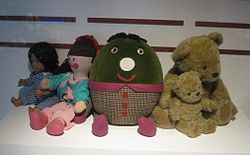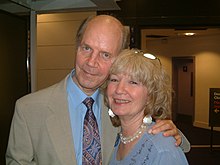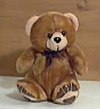Play School (British TV series)
| Play School (UK) | |
|---|---|
 The toys: Poppy, Jemima, Humpty, Little Ted, Big Ted, on display at the National Science and Media Museum | |
| Genre | Children's television series |
| Created by | Joy Whitby |
| Starring | Various presenters |
| Country of origin | United Kingdom |
| Original language | English |
| Production | |
| Executive producer | Cynthia Felgate (1972–1983) |
| Running time | 23 minutes |
| Release | |
| Original network | BBC2 also BBC1 from 1983 |
| Picture format | PAL |
| Audio format | Mono |
| Original release | 21 April 1964 – 11 March 1988 |
Play School was a British children's television series produced by the BBC which ran from 21 April 1964 until 11 March 1988. It was created by Joy Whitby and was aimed at preschool children.[1] Each programme followed a broad theme and consisted of songs, stories and activities with presenters in the studio, along with a short film introduced through either the square, round or arched window in the set.
The programme spawned numerous spin-offs in Britain and other countries and involved many presenters and musicians during its run. Despite a revamp in 1983 Play School maintained the same basic formula throughout its 24-year history, but changes to the BBC's children's output led to the programme's cancellation in 1988, when it was replaced by Playbus, which soon became Playdays.
Broadcast history[]
Play School originally appeared on weekdays at 11 am on BBC2 and received holiday runs on BBC1 in Summer 1964 and 1965, later acquiring a mid-afternoon BBC1 repeat as the opening programme of BBC1's teatime children's schedule. The morning showing was transferred to BBC1 in September 1983 when BBC Schools programming transferred to BBC2. It remained in that slot even after daytime television was launched in October 1986 and continued to be broadcast at that time until it was superseded in October 1988 by Playbus.
When the BBC scrapped the afternoon edition of Play School in April 1985, to make way for a variety of children's programmes in the afternoon, a Sunday morning compilation was launched called Hello Again!.
There were several opening sequences for Play School during its run, the first being "Here's a house, here's a door. Windows: 1 2 3 4. Ready to knock? Turn the lock – It's Play School." This changed in the early 1970s to "A house - with a door. 1, 2, 3, 4. Ready to play? What's the day? It's..." In this version blinds opened on the windows as the numbers were spoken.
The blinds were no longer featured towards the end of the 1970s and the word "windows" was added before "1 2 3 4". The final opening sequence involved a multicoloured house with no apparent windows. This was used from 1983 until the end of the programme. This saw the most radical revamp of the programme overall (not just in the opening titles). The opening legend then became "Get ready. To play. What's the day? It's..."
Unlike earlier BBC programmes aimed at preschool children such as Watch with Mother, Play School featured real presenters who spoke directly to their audience.[2] Presenters included the first black host of a children's show, Paul Danquah; Brian Cant, who remained with the show for 21 years; actress Julie Stevens; TV personality Johnny Ball; former pop singers Lionel Morton and Toni Arthur; husband and wife Eric Thompson and Phyllida Law; Italian model and actress Marla Landi; and Balamory producer Brian Jameson. Don Spencer and Diane Dorgan also appeared on the Australian version.[3] Play School and another BBC children's television programme Jackanory were sometimes recorded at BBC Birmingham or BBC Manchester when BBC Television Centre in London was busy.
Contents of the show[]

A section of each episode was a filmed excursion into the outside world taken through one of three windows: the young viewers were invited to guess whether the round, square, or arched window would be chosen that day, usually by means of the phrase, "...Have a look – through the....(whichever) window." A triangular window was added in 1983. Very often the film would be of a factory producing something such as chocolate biscuits, or of a domestic industry such as refuse collection, but a number of subject matters were covered, such as watching animals or fish, boats on a lake, children in a playground or at school, a family going tenpin bowling, people in a cafe and visiting a jumble sale, among other things.
At the beginning of the 1983 revamp, the windows were now referred to as "shapes" as in "'let's have a look through one of the shapes..." After the shapes were moved to a spinning disc, the programme went back to using windows which resembled those used in the late 70s, albeit with the addition of the triangular window. Whenever they were shown now, only the window that the show was using for the day would be the one that would be used on the set.
Each episode would also include a short story read from a book, introduced by checking the time on a clock. Normally the clock would show either an hour or a half hour and the young viewers were asked, "Can you tell what time the clock says today? Well, the long hand is pointing straight up, so that means it's something o'clock – and the short hand is pointing to the number...two (or whatever). So today, the clock says, two...o'...clock" (the latter phrase always delivered very slowly). This was followed by, "But what's underneath the clock?", and viewers would then see a turntable under the clock featuring certain items such as toy animals or clocks, which were, in a clever twist, always a clue to the forthcoming story. This was all accompanied by a slightly eerie, yet undeniably catchy, clock-like tune. (On one occasion, the item under the clock turned out to be none other than Little Ted, so the presenter concerned said, "What a very odd place for a toy to be!" and the story appropriately turned out to be about odd things.)
Both the clock and the three window option live on in the children's programme Tikkabilla, which borrows much from Play School, while a similar choice of portal into a film clip was provided by the abdomen-mounted video displays in the children's show Teletubbies.
Most of the programmes were studio-based, but there were a number of outside broadcasts at a variety of locations, such as zoos, seasides, central London, churches, schools and farms.
There would also be songs, games, poems and stories, as well as regular painting and craft activities. The presenters would frequently invite the younger viewers to participate at home, usually by means of the prompt, 'Can you do that?' They normally signed off at the end of each episode by saying, "Time for us to go now, but only until tomorrow, so goodbye until tomorrow" – or, at the end of a week, "Goodbye, until it's our turn to be here again". (The latter phrase stemmed from the fact that the presenters changed from one week to the next.)
From 1971 to 1984, Play School also had a sister programme called Play Away.
Many 2 inch Quadruplex videotape master copies of Play School editions were wiped by the BBC in 1993 on the assumption that they were of no further use and that examples of some other episodes were sufficient.[4]
Overseas sales and adoption[]

Play School was sold to Australia, and was then followed by local production. The Australian version has been produced since 1966. Similarly New Zealand bought the programme before producing their own from 1972 to 1982 & 1986 to 1989. The Canadian adaptation was Polka Dot Door and ran from 1971 to 1993.
Other countries including Lekestue in Norway (1971–81), Das Spielhaus in Switzerland and Austria (1968-1986), Giocagiò in Italy (1966-1970), La Casa Del Reloj in Spain (1971–74), and Israel were provided with scripts and film segments so they could produce their own versions.[5]
Presenters[]
The first show was presented by Virginia Stride and Gordon Rollings. Other presenters throughout the 24-year run included
- Rick Jones
- Carole Ward
- Brian Cant
- Eric Thompson and his wife Phyllida Law
- Julie Stevens
- Terence Frisby (as Terence Holland)
- Marla Landi
- Paul Danquah
- Gordon Clyde
- Valerie Pitts
- Colin Jeavons
- Carol Chell
- Miranda Connell
- Wally Whyton
- Ann Morrish
- John White
- Johnny Ball
- Lionel Morton
- Chloe Ashcroft and her husband David Hargreaves
- Diane Dorgan
- Johnny Silvo
- Derek Griffiths
- Beryl Roques
- Sarah Long
- Toni Arthur
- Carmen Munroe
- Don Spencer
- Jon Glover
- Fred Harris
- John Golder
- Karen Platt
- Carol Leader
- Stuart McGugan
- Chris Tranchell
- Floella Benjamin
- Ben Bazell
- Sheelagh Gilbey
- Elizabeth Millbank
- Ben Thomas
- Christopher Bramwell
- Lucie Skeaping
- Iain Lauchlan
- Patrick Abernethy
- Elizabeth Watts (presenter)
- Brian Jameson
- Wayne Jackman
- Jane Hardy
- Stuart Bradley
- Kate Copstick
- Delia Morgan
- Mike Amatt
Only four of these presenters presented the programme during all three decades of its existence, namely Brian Cant (1964–85), Carol Chell (1966–88), Johnny Ball (1967–84 & 1986–87) and Chloe Ashcroft (1969–88). Chell was both the longest-serving presenter and the one who made the most appearances on the programme (763 in total). In addition, two regular presenters from the 1960s and 1970s, namely Lionel Morton and Colin Jeavons, made a few guest appearances on the programme during the 1980s. Other presenters who were on the programme for 10 or more years included Julie Stevens, Derek Griffiths, Fred Harris, Don Spencer, Sarah Long, Floella Benjamin, Stuart McGugan and Carol Leader.[6]
In many cases five programmes would be produced in the space of two days,[3] with one day of rehearsal and one day of recording.
Celebrity storytellers[]
A number of famous people also appeared on the show as storytellers: many became semi-regulars. They included: Val Doonican, Richard Baker, Rolf Harris, Clive Dunn, Roy Castle, Pat Coombs, David Kossoff, Patricia Hayes, Sam Kydd, James Blades, Frank Windsor, Roy Kinnear, George Chisholm, Ted Moult and Cilla Black. Both existing and former Play School presenters also frequently made guest appearances as storytellers.[7]
Musicians[]
Many musicians worked on the programme over the years: they included Jonathan Cohen, William Blezard, Peter Gosling, Alan Grahame, Paul Reade, Spike Heatley, Alan Rushton, Pedro Goble, Anne Dudley, John Gould, Martin Yates and Peter Pettinger. Some of them, in particular Cohen, Gosling, Grahame and Reade, occasionally appeared on camera, especially during Christmas editions.[6]
Toys[]
The presenters were accompanied by a supporting cast of cuddly toys and dolls. The five regulars included:
- Humpty, a dark green large egg-shaped soft toy with green trousers, to look like Humpty Dumpty from the nursery rhyme, appeared in the very first programme in April 1964. Several versions were made.
- Big Ted and Little Ted, twin teddy bears. (Originally there was only the one Teddy, however this was stolen in the mid-1970s and replaced by the two Teds.)
- Jemima, a rag doll with long red (or pink) and white striped legs.
- Hamble was a little doll and one of the original five toys but dropped from the show during the 1980s to be replaced by Poppy. According to Joy Whitby, creator of Play School, Hamble was chosen as representative of a more "downtrodden", humble background than the "middle-class" associations that the teddy bears had.[8] She was disliked by presenters as she could not be cuddled.[9] According to the BBC website Chloe Ashcroft "did a terrible thing to Hamble. She just would not sit up...so one day I got a very big knitting needle, a big wooden one, and I stuck it right up her bum, as far as her head. So she was completely rigid, and she was much much better after that."[9] (This was mentioned in a BBC Radio 4 programme called Trumpton Riots, available on YouTube.) In the edition called Through The Arched Window (in which the Radio Times said that Chloe Ashcroft would be interviewed and wasn't) the knitting needle incident was mentioned; however, the person admitting to it was Julie Stevens.[citation needed])
- Poppy, a black doll who replaced Hamble in November 1986, in response to changing attitudes in society (the Hamble doll was also getting rather fragile at this point).
A rocking horse named Dapple was first seen in May 1965 and made occasional appearances, when a particular song or item suggested it. The final line up of toys are on display as exhibits of the National Science and Media Museum, Bradford. However Hamble went missing after being dropped from the programme. The original Humpty and Jemima were developed by soft toy makers "Ostrobogulous Toys" run by Kristin Baybars, daughter of Blair Hughes-Stanton and Ida Affleck Graves.[10]
Pets[]
- Katoo, Charlie and Sparky – cockatoo
- Bit and Bot – goldfish
- Rabbits, including Buffy, Mopsy, Peter, Benjamin and Becky.
- Mice
- Guinea pigs including Lizzy
The pets were cared for by Wendy Duggan, Fellow of the Zoological Society.[11]
See also[]
- Play Away
- Playdays
- Tikkabilla
- Show Me Show Me
- Play School (Australian TV series)
- Play School (New Zealand TV series)
- Polka Dot Door
- ZOOM (1972 TV series)
- Mister Rogers' Neighborhood
- Captain Kangaroo
- Sesame Street
Notes[]
- ^ Sheridan, Simon (2004). The A-Z of Classic Children's Television: From Alberto Frog to Zebedee. Reynolds & Hearn Ltd. pp. 206–210. ISBN 1903111277.
- ^ "Play School". BBC Cult Classic TV. BBC. Retrieved 31 July 2018.
- ^ Jump up to: a b Williams, Sarah (15 October 2012). "How we made: Joy Whitby and Phyllida Law on Play School". The Guardian. Archived from the original on 16 October 2012. Retrieved 16 October 2012.
- ^ [1]
- ^ BBC press release Cult Classic bbc.co.uk
- ^ Jump up to: a b *Paul R Jackson Here's A House – A Celebration of Play School Kaleidoscope
- Volume 1 (2010)
- Volume 2 (2011)
- ^ Here's A House, Paul R Jackson, 2010/2011
- ^ Joyce Whitby, Creator of Play School, Children's TV on Trial. BBC Television, broadcast 28 May 2007
- ^ Jump up to: a b The Reunion: Play School BBC Radio 4, 19 September 2010 on BBC iPlayer
- ^ Adrian Baldwin (2020) More on Ostrobogulous Toys, blog post, 7th July 2020.
- ^ Bob Chaundy Obituary: Wendy Duggan, The Guardian, 4 March 2012
References[]
- 25 Minutes Peace – Celebrating Play School (BBC TV programme, 1979)
- Paul R Jackson, Here's A House – A Celebration of Play School Kaleidoscope
- Volume 1 (2010)
- Volume 2 (2011)
External links[]
- 1964 British television series debuts
- 1988 British television series endings
- 1960s British children's television series
- 1970s British children's television series
- 1980s British children's television series
- British television shows featuring puppetry
- BBC children's television shows
- Lost BBC episodes
- British preschool education television series
- 1960s preschool education television series
- 1970s preschool education television series
- 1980s preschool education television series
- English-language television shows
- Television series about bears
- Television series about horses
